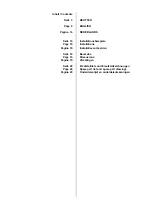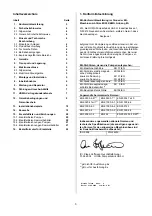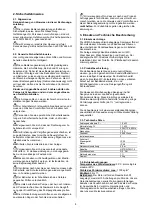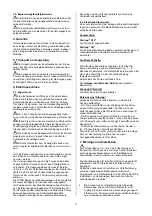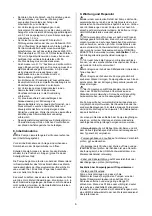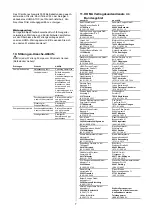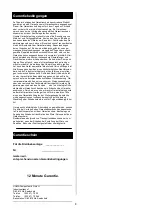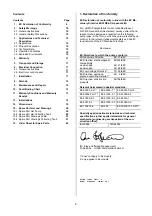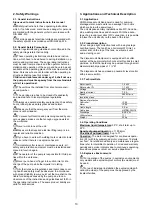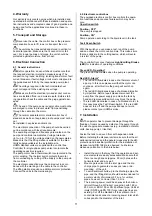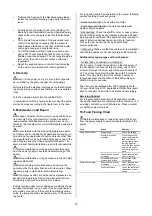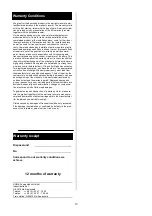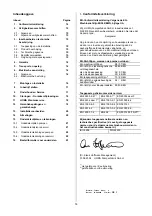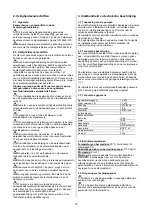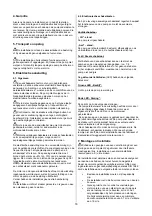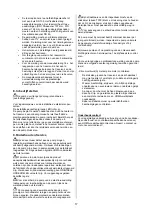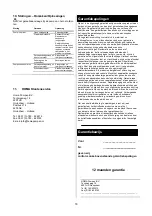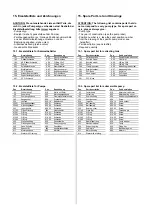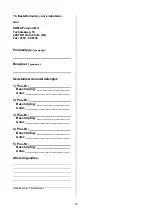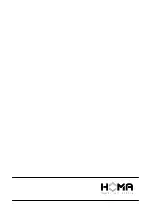
12
•
To prevent a freezing of the discharge pipe please
isolate the complete discharge pipe up to the sewer
level.
•
Directly above the swing check valve (Saniboy I R,
Saniboy II and Sanimaster have an integrated swing
check valve) mount a gate valve into the discharge
pipe.
•
For a trouble free operation of the pneumatic level
control it is absolutly necessary that the pressure
hose between tank and control box is installed with-
out loops, bending and constantly rising.
•
Cut off the blanked off end of the air vent and con-
nect a DN 70 vent pipe to the tank by means of the
flexible connection supplied. The vent pipe should be
led out into the open air in accordance with local
regulations.
•
Mount the supplied pump controller flood protected
on the wall in accordance with local regulations.
8. Start-Up
Never let the pump run dry for a long time of period,
as it will destroy the pump (danger of overheating).
Before starting the disposal unit make sure that all isolat-
ing valves are open and check that the unit runs satisfac-
torily.
Turn the operation switch into the position "ON".
In combination with the pneumatic level control the pump
starts and stops according to the liquid level in the tank.
9. Maintenance and Repair
In case of a defect of the pump, a repair shall be car-
ried out only by the manufacturer or through an author-
ized workshop. Modifications of the pump must be con-
firmed by the manufacturer. Only HOMA spare parts shall
be used.
In accordance with the product liability law we point
out that we shall not be liable for damages caused by our
product due to unauthorized repair by persons other than
the manufacturer or an authorized workshop or due to the
use of spare parts other than original HOMA parts. The
same product liability limitations are valid for accessories.
Before maintenance or repair disconnect the pump
from the power supply to avoid accidental starting of the
pump!
Before maintenance or repair make sure that all rotat-
ing parts stand still!
Before carrying out maintenance and service, the
pump must be thoroughly flushed with clean water. Rinse
the pump parts in clean water after dismanteling.
At pump types with oil chamber an overpressure can
escape with loosening of the oil chamber control screw.
Screw only when pressure balance took place.
Pumps running under normal operation conditions should
be inspected at least once a year. If the pumped liquid is
very muddy or sandy or if the pump is operating continu-
ously, the pump should be inspected every 1.000 operat-
ing hours.
For long and trouble-free operation of the pump, following
points should be checked regularly:
- Nominal current (A): Check with amp-meter.
- Pump parts and impeller: Check for possible wear.
Replace defective parts.
- Ball bearings: Check the shaft for noisy or heavy opera-
tion (turn the shaft by hand). Replace defective ball bear-
ings. A general overhaul of the pump is usally required in
case of defective ball bearings or poor motor function.
This work must be carried out by an authorized
service workshop.
- Cable entry: Make sure that the cable entry is watertight
and that the cables are not bent sharply and/or pinched.
Additionally at pump types with oil chamber:
- Oil level and oil condition in oil chamber:
Put the pump in horizontal position, so that the screw of
the oil chamber is above (at larger pumps: one of both
screws). Remove the screw and infer a small quantity of
oil. The oil becomes greyish white like milk if it contains
water. This may be the result of defective shaft seal.
In this case leave the condition of the shaft seals by a
HOMA Service to examine.
The oil should be replaced after 3000 operating hours.
Oil type: Shell Tellus C22, degradable HOMA-Atox (avail-
able on request). Used oil is to be disposed accordingly.
Servicing Contract
For a regular expert execution of all necessary mainte-
nance and inspection we recommend the conclusion of a
servicing contract by our HOMA Service. Please contact
our HOMA customer service.
10. Fault Finding Chart
Before maintenance or repair disconnect the pump
from the power supply to avoid accidental starting of the
pump!
Fault Cause Remedy
Pump does not start
Supply failure
Check the voltage
Impeller blocked by
impurities
Close the incoming
sewer, emptying the
tank with the dia-
phragm pump, open
the clening cover,
clean the tank by hand
and remove solids
which may block the
pump
Pressure hose is leaky
or clogging
Check the hose and
clean or replace
Fuses blow due to use
of wrong type of fuse
Install fuses of the
correct type
Pump does not stop
Pressure hose is leaky
or clogging
Check the hose and
clean or replace
Control box failure
Check the control box
and replace it if nec-
essary


